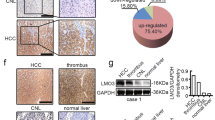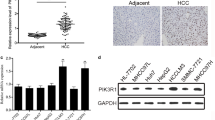Abstract
The objective of this study is to clarify the possible role and mechanism of Axl in the tumorigenicity and metastasis process of hepatocellular carcinoma. The mRNA and protein expression levels of Axl in MHCC97-H and MHCC97-L cell lines were evaluated by real-time PCR and Western blot analysis. The key factor of phosphatidylinositol-3-kinase (PI3K)/Akt-p21-activated kinases-1 (PAK1) signaling pathway was studied after Axl expression was downregulated by shRNA. Finally, we analyzed the expression status of Axl protein expression in hepatocellular carcinoma tissues and its relationship with the prognosis of hepatocellular carcinoma. Axl was observed to be higher expressed in MHCC97-H cell lines compared to MHCC97-L cell lines. The downregulation of Axl in MHCC97-H cell lines resulted in the inhibition of the invasion ability of MHCC97-H cells both in vitro and in vivo. Interestingly, blocking PI3K/Akt signaling pathway by LY294002 or Akt siRNA could remarkably inhibit the PAK1 activation and cell invasion. Finally, the Axl protein expression was positively correlated with differentiation, lymph node metastasis, and clinical stage in patients with hepatocellular carcinoma patients (all P < 0.01). These findings suggest that Axl can also regulate the metastasis process of hepatocellular carcinoma and may serve as a new prognostic marker and therapeutic target for treating hepatocellular carcinoma metastasis.





Similar content being viewed by others
References
Gschwind A, Fischer OM, Ullrich A. The discovery of receptor tyrosine kinases: targets for cancer therapy. Nat Rev Cancer. 2004;4:361–70.
Stitt TN, Conn G, Gore M, Lai C, Bruno J, Radziejewski C, et al. The anticoagulation factor protein S and its relative, Gas6, are ligands for the Tyro 3/Axl family of receptor tyrosine kinases. Cell. 1995;80:661–70.
Linger RM, Keating AK, Earp HS, Graham DK. TAM receptor tyrosine kinases: biologic functions, signaling, and potential therapeutic targeting in human cancer. Adv Cancer Res. 2008;100:35–83.
O’Bryan JP, Frye RA, Cogswell PC, Neubauer A, Kitch B, Prokop C, et al. Axl, a transforming gene isolated from primary human myeloid leukemia cells, encodes a novel receptor tyrosine kinase. Mol Cell Biol. 1991;11:5016–31.
Sun W, Fujimoto J, Tamaya T. Coexpression of Gas6/Axl in human ovarian cancers. Oncology. 2004;66:450–7.
Craven RJ, Xu LH, Weiner TM, Fridell YW, Dent GA, et al. Receptor tyrosine kinases expressed in metastatic colon cancer. Int J Cancer. 1995;60:791–7.
Nemoto T, Ohashi K, Akashi T, Johnson JD, Hirokawa K. Overexpression of protein tyrosine kinases in human oesophageal cancer. Pathobiology. 1997;65:195–203.
Ito M, Nakashima M, Nakayama T, Ohtsuru A, Nagayama YJ, Takamura N, et al. Expression of receptor-type tyrosine kinase, Axl, and its ligand, Gas6, in pediatric thyroid carcinomas around chernobyl. Thyroid. 2002;12:971–5.
Zantek ND, Walker-Daniels J, Stewart J, Hansen RK, Robinson D, Miao H, et al. MCF-10A-NeoST: a new cell system for studying cell-ECM and cell–cell interactions in breast cancer. Clin Cancer Res. 2001;7:3640–8.
Shieh YS, Lai CY, Kao YR, Shiah SG, Chu YW, Lee HS, et al. Expression of axl in lung adenocarcinoma and correlation with tumour progression. Neoplasia. 2005;7:1058–64.
Hafizi S, Dahlbäck B. Signaling and functional diversity within the Axl subfamily of receptor tyrosine kinases. Cytokine Growth Factor Rev. 2006;17:295–304.
Tomita Y, Morooka T, Hoshida Y, Zhang B, Qiu Y, Nakamichi I, et al. Prognostic significance of activated AKT expression in soft-tissue sarcoma. Clin Cancer Res. 2006;12(3):3070–7.
Cinti C, Vindigni C, Zamparelli A, La Sala D, Epistolato MC, Marrelli D, et al. Activated Akt as an indicator of prognosis in gastric cancer. Virchows Arch. 2008;453(5):449–55.
Chadha KS, Khoury T, Yu J, Black JD, Gibbs JF, Kuvshinoff BW, et al. Activated Akt and Erk expression and survival after surgery in pancreatic carcinoma. Ann Surg Oncol. 2006;13(7):933–9.
Park SS, Kim SW. Activated Akt signaling pathway in invasive ductal carcinoma of the breast: correlation with HER2 overexpression. Oncol Rep. 2007;18(1):139–43.
Papakonstanti EA, Stournaras C. Association of PI-3 kinase with PAK1 leads to actin phosphorylation and cytoskeletal reorganization. Mol Biol Cell. 2002;13:2946–62.
He L, Zhang J, Jiang L, Jin C, Zhao Y, Yang G, et al. Differential expression of Axl in hepatocellular carcinoma and correlation with tumor lymphatic metastasis. Mol Carcinog. 2010;49(10):882–91.
Li J, Jia L, Ma ZH, Ma QH, Yang XH, Zhao YF. Axl glycosylation mediates tumor cell proliferation, invasion and lymphatic metastasis in murine hepatocellular carcino. World J Gastroenterol. 2012;18(38):5369–76.
Tian J, Tang ZY, Ye SL, Liu YK, Lin ZY, Chen J, et al. New human hepatocellular carcinoma (HCC) cell line with highly metastatic potential (MHCC97) and its expressions of the factors associated with metastasis. Br J Cancer. 1999;81:814–21.
Schutte K, Bornschein J, Malfertheiner P. Hepatocellular carcinoma—epidemiological trends and risk factors. Dig Dis. 2009;27:80–92.
Vajkoczy P, Knyazev P, Kunkel A, Capelle HH, Behrndt S, von Tengg-Kobligk H, et al. Dominant-negative inhibition of the Axl receptor tyrosine kinase suppresses brain tumor cell growth and invasion and prolongs survival. Proc Natl Acad Sci U S A. 2006;103:5799–804.
Tai KY, Shieh YS, Lee CS, Shiah SG, Wu CW. Axl promotes cell invasion by inducing MMP-9 activity through activation of NF-kappaB and Brg-1. Oncogene. 2008;27:4044–55.
Christofori G. New signals from the invasive front. Nature. 2006;41:444–50.
Zhang YX, Knyazev PG, Cheburkin YV, Sharma K, Knyazev YP, Orfi L, et al. AXL is a potential target for therapeutic intervention in breast cancer progression. Cancer Res. 2008;68:1905–15.
Acknowledgments
This work was supported by a grant from The National Natural Science Foundation of China director fund (81250025).
Conflicts of interest
None
Author information
Authors and Affiliations
Corresponding author
Rights and permissions
About this article
Cite this article
Xu, J., Jia, L., Ma, H. et al. Axl gene knockdown inhibits the metastasis properties of hepatocellular carcinoma via PI3K/Akt-PAK1 signal pathway. Tumor Biol. 35, 3809–3817 (2014). https://doi.org/10.1007/s13277-013-1521-5
Received:
Accepted:
Published:
Issue Date:
DOI: https://doi.org/10.1007/s13277-013-1521-5




